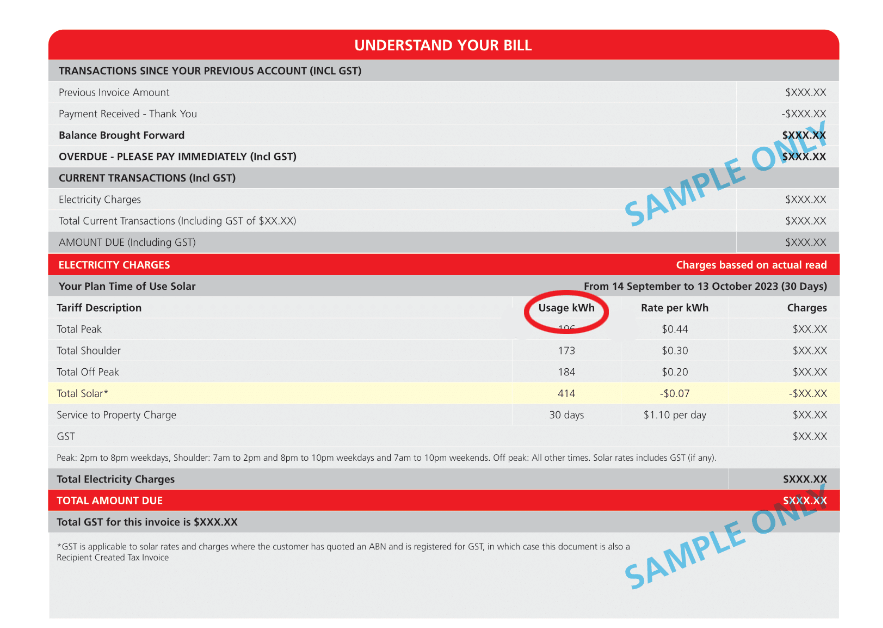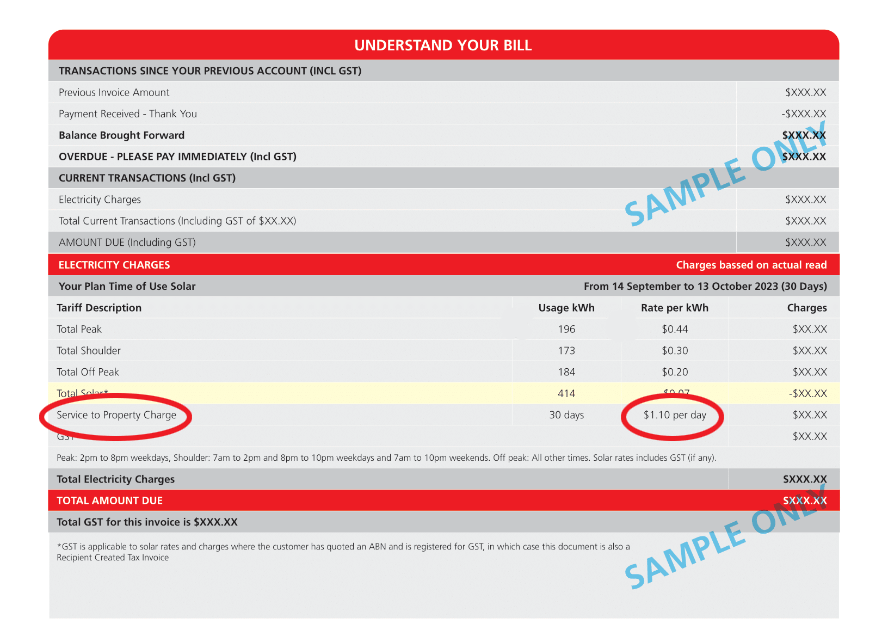KEY POINTS
- A tariff refers to how your energy provider charges customers for their energy usage.
- There are seven types of tariffs in Victoria: single rate, block rate, flexible pricing, time of use, demand, controlled load and feed-in tariffs.
- Customers with solar panels can sign up for a feed-in tariff, rewarding them with bill credits for surplus energy exported back to the grid.
Compare cheap electricity plans in Victoria
Here are some sponsored deals from the retailers on our database that include a link to the retailer’s website for further details. These are products from referral partners†. These costs are based on the Citipower network in Melbourne but prices may vary depending on your circumstances. This comparison assumes general energy usage of 4000kWh/year for a residential customer on a single rate tariff. Please use our comparison tool for a specific comparison in your area and to see other products in our database that may be available. Our database may not cover all deals in your area. As always, check all details of any plan directly with the retailer before making a purchase decision.
 |
|
10% Less than VDO |
$1,392 Price/year (estimated) |
Go to Site |
Here are some of the cheapest published deals from the retailers on our database that include a link to the retailer’s website for further details. These are products from referral partners†. Costs are based on the Citipower network in Melbourne but prices may vary depending on your circumstances. This comparison assumes general energy usage of 4000kWh/year for a residential customer on a single rate tariff. Please use our comparison tool for a specific comparison in your area and to see other products in our database that may be available. Our database may not cover all deals in your area. As always, check all details of any plan directly with the retailer before making a purchase decision.
What is an electricity tariff?
Before we go in to detail about tariffs, it’s important to understand the types of charges. There are supply charges and usage charges.
- Supply: A daily fee that applies regardless of how much or how little electricity is used.
- Usage: A charge applied for each kWh of electricity supplied to the property.
An electricity tariff refers to the way your energy provider charges customers for electricity usage. You may pay the same rate for electricity at all times of the day, or you may be charged different rates depending on the time you use power. There are a few residential energy tariffs that Victorians need to be aware of, though tariffs may be unavailable on some networks or through certain retailers. While some tariffs are limited to certain distribution networks, some common tariffs on offer to Victorian electricity customers include:
- Single rate tariff
- Block rate tariff
- Flexible pricing tariff
- Time of use tariff
- Demand tariff
- Controlled load (two-rate) tariff
- Feed-in tariff
Single rate tariff
A single rate tariff charges the same rate for all electricity used, regardless of when or how you use power. This tariff is also known as a ‘peak’, ‘anytime’, or ‘flat rate’ tariff. This is the simplest type of tariff and is available with any meter type.
Usage rates on a single rate tariff in Melbourne are generally charged between 15c/kWh and 25c/kWh depending on the network and retailer. A single rate tariff might be the most affordable option for households that use a lot of electricity during peak demand periods in the afternoon and evening. In fact, it was the ‘go-to’ prior to the mandated roll out of smart meters.
Households with smart meters may have automatically been switched to a flexible price tariff. However, if you would prefer a single rate, contact your retailer to organise a reconfiguration of your meter. If you’re on a flexible pricing tariff and don’t realise, it could cost you dearly.
Single rate tariff costs
Here is an example of what Victorian households can expect to pay if they have a single rate tariff.
Here are some of the cheapest published deals from the retailers on our database that include a link to the retailer’s website for further details. These are products from referral partners†. Costs are based on the Citipower network in Melbourne but prices may vary depending on your circumstances. This comparison assumes general energy usage of 4000kWh/year for a residential customer on a single rate tariff. Please use our comparison tool for a specific comparison in your area and to see other products in our database that may be available. Our database may not cover all deals in your area. As always, check all details of any plan directly with the retailer before making a purchase decision. The next three tabs feature products exclusively from AGL, EnergyAustralia and Origin.
Here are the AGL Energy plans on our database for Victoria. These are products from a referral partner†. These costs are based on the Citipower network in Melbourne but prices may vary depending on your circumstances. This comparison assumes general energy usage of 4000kWh/year for a residential customer on a single rate tariff. Please use our comparison tool for a specific comparison in your area and to see other products in our database that may be available. Our database may not cover all deals in your area. As always, check all details of any plan directly with the retailer before making a purchase decision.
Here are the EnergyAustralia plans on our database for Victoria. These are products from a referral partner†. These costs are based on the Citipower network in Melbourne but prices may vary depending on your circumstances. This comparison assumes general energy usage of 4000kWh/year for a residential customer on a single rate tariff. Please use our comparison tool for a specific comparison in your area and to see other products in our database that may be available. Our database may not cover all deals in your area. As always, check all details of any plan directly with the retailer before making a purchase decision.
Here are the Origin Energy plans on our database for Victoria. These are products from a referral partner†. These costs are based on the Citipower energy network in Melbourne but prices may vary depending on your circumstances. This comparison assumes general energy usage of 4000kWh/year for a residential customer on a single rate tariff. Please use our comparison tool for a specific comparison in your area and to see other products in our database that may be available. Our database may not cover all deals in your area. As always, check all details of any plan directly with the retailer before making a purchase decision.
Block rate tariff
Customers on a block rate tariff are charged one rate for their first ‘block’ of electricity, and another rate for all remaining usage. A block of usage refers to a set amount of electricity used per day, month or quarter. A typical rate for the first block of usage is between 24c and 34c/kWh. The rate for the second block is slightly higher or lower, depending on the retailer. The following tables illustrate what a block rate tariff might look like.
Monthly blocks
← Mobile/tablet users, scroll sideways to view full table →
| Usage block | Rate |
|---|---|
| First 340kWh | 29c/kWh |
| Remaining usage | 28c/kWh |
Daily blocks
← Mobile/tablet users, scroll sideways to view full table →
| Usage block | Rate |
|---|---|
| First 11.2kWh | 27c/kWh |
| Balance | 28.5c/kWh |
Above data is for general information only.
Keep in mind that while most households exceed the first usage block, and possibly benefit from the slightly cheaper rates on remaining usage, savings on a block rate tariff compared to a single rate tariff are often relatively minor.
Flexible pricing
Smart meter rollouts in Victoria were accompanied by new ‘flexible pricing’ tariff. This tariff applies a different electricity usage rate depending on what time electricity is used.
There are three periods: peak, off-peak and shoulder.
- Peak: Electricity is in high demand at these times, so retailers charge higher rates
- Off-peak: Electricity is in low demand at these times, so the lowest rate is charged
- Shoulder: This is between peak and off-peak periods. Electricity is in mild demand and a medium price is charged.
← Mobile/tablet users, scroll sideways to view full table →
| Peak hours | Off-peak hours | Shoulder | |
|---|---|---|---|
| Hours | 3pm-9pm weekdays | 10pm-7am everyday | 7am-10pm weekends, 9pm-10pm & 7am-3pm weekdays |
| Typical rate | 40c/kWh – 50c/kWh | 15c/kWh – 24c/kWh | 32c/kWh –39c/kWh |
Above data is for general information only.
No peak periods exist on weekends. Instead, a shoulder rate is charged for most of the day. Some retailers may also charge different rates across winter and summer months.
Higher rates are sometimes applied by electricity retailers in summer months compared to ‘non-summer’ months. The summer months are considered to be from October 1 to March 31 for customers on the Jemena, Ausnet Services and United Energy networks. Summer months on the Powercor and Citipower networks are from December 1 to February 28.
While flexible pricing tariffs are a popular choice, they might not be the most affordable option for households and businesses that use a lot of electricity during peak demand periods. If you’re on a flexible pricing tariff, try maximising electricity use between 10pm and 7am. Use appliance timers or hold off using large appliances like dishwashers and washing machines until the off-peak period kicks in.
Time of use tariff
The time of use tariff is similar to flexible pricing in that different rates are charged depending on the time of day. Unlike the flexible pricing tariff, a time of use tariff doesn’t include a ‘shoulder’ period – only peak and off-peak. Different time brackets also exist, as a time of use tariff has a much wider peak demand period – albeit at a slightly lower rate than a flexible pricing tariff.
Time of use tariff hours and rates
← Mobile/tablet users, scroll sideways to view full table →
| Peak | Off-peak | |
|---|---|---|
| Hours | 7am-11pm | 11pm-7am |
| Typical rate | 32c/kWh to 41c/kWh | 14c/kWh to 20c/kWh |
Above data is for general information only.
It is not entirely clear whether a time of use tariff can save you more than a flexible pricing tariff. Although peak demand with time of use tariffs is slightly cheaper, it is more expensive than shoulder periods under flexible pricing. If you believe your property uses a ridiculous amount of electricity between the hours of 3pm and 9pm, then a time of use tariff might save slightly more money than flexible pricing. That said, unless you take advantage of the low off-peak rates, you might be better suited to a single rate or block tariff.
Demand tariff
Demand tariffs are relatively new to the residential market and are a little trickier to wrap your head around. Customers are charged a lower rate through either a single or block rate structure in exchange for a ‘demand charge’, in addition to standard usage and supply rates.
A demand charge is a daily or monthly fixed fee that is calculated using the maximum half-hourly interval kW demand occurring on a weekday between 3pm and 9pm in that month. This means that if you’re running multiple high energy appliances at once on a one-off occasion, a higher demand charge is applied for the entire month. Base demand charges are also considerably higher around the summer months (December to March).
While the reduced usage rates can help you save, you might end up paying a lot more if your electricity usage gets out of hand for even a moment. Since it’s a risky tariff customers must approach their retailer directly to opt in to this arrangement.
Controlled load/two-rate tariff
Under a two-rate tariff (also known as a controlled load or dedicated circuit), customers can nominate one or more appliances to have metered separately and charged at a cheaper rate than the rest of the property. The catch is energy is only supplied to nominated appliances during off-peak hours (usually 11pm to 7am), meaning it’s not ideal for most appliances.
Two-rate tariffs are most commonly used with electric storage hot water systems, heat slabs, pool pumps or any appliance that doesn’t need to run throughout the day. Only the nominated appliance will receive a lower usage rate, while the rest of the property’s electricity usage is metered on one of the previously mentioned tariffs.
Feed-in tariff
Households with solar panels can receive what is called a ‘feed-in tariff’ or FiT. When your solar panels produce electricity and no one is at home to use it, surplus electricity is fed into the grid for another property to use instead. In exchange, your electricity retailer will give a small FiT credit for each kWh of energy your solar system exported. Under state regulation, customers on a single rate tariff will receive a minimum feed-in tariff of 6.7c/kWh, however some retailers will offer slightly more than this. Read Canstar Blue’s feed-in tariff comparison for more information.
Electricity rates Victoria
Here are the general electricity usage rates and daily supply charges for households in Victoria. These rates are based on residential customers who live in Melbourne, on the Citipower network. We list the rates of some of the cheapest published deals available on our database from each retailer for single rate tariffs only.
← Mobile/tablet users, scroll sideways to view full table →
| Electricity provider | Electricity plan | General usage rate | Daily supply charge | |
|---|---|---|---|---|
| AGL | AGL Residential Smart Saver | 24.60¢/kWh | 111.66¢/day | |
| Alinta Energy | HomeSaver On | 24.05¢/kWh | 109.19¢/kWh | |
| Amber Electric | Standing Offer: Fixed Rate | 26.19¢/kWh | 54.33¢/day | |
| Arcline by RACV | Home Energy Plan | 25.41¢/kWh | 115.38¢/day | |
| CovaU Energy | Basics Residential Single | 27.34¢/kWh | 124.07¢/day | |
| Diamond Energy | Everyday Renewable Saver | 26.46¢/kWh | 120.95¢/day | |
| Dodo | Market Offer | 26.78¢/kWh | 93.38¢/day | |
| EnergyAustralia | Flexi Plan – Peak Only | 27.33¢/kWh | 124.07¢/day | |
| Energy Locals | Online Member – $100 Special | 28.00¢/kWh | 74.50¢/day | |
| Engie | Engie Perks | 27.32¢/kWh | 124.07¢/day | |
| GloBird Energy | Boost Residential | 20.79¢/kWh | 115.50¢/day | |
| Kogan Energy | Kogan Energy With Free First | 23.25¢/kWh | 101.15¢/day | |
| Lumo Energy | Lumo Value | 23.70¢/kWh | 107.64¢/day | |
| Momentum Energy | Warm Welcome | 23.10¢/kWh | 116.60¢/day | |
| Nectr | Home Buzz | 27.33¢/kWh | 124.07¢/day | |
| Origin Energy | Go Variable | 24.60¢/kWh | 111.67¢/day | |
| OVO Energy | The One Plan | 24.33¢/kWh | 100.10¢/day | |
| Pacific Blue | Blue First | 27.28¢/kWh | 91.30¢/day | |
| Powershop | Power House | 23.25¢/kWh | 101.15¢/day | |
| Red Energy | Living Energy Saver | 24.59¢/kWh | 111.65¢/day | |
| Sumo | Sumo Standing Offer | 27.32¢/kWh | 124.07¢/day | |
| Tango Energy | Eselect | 27.28¢/kWh | 91.30¢/day | |
| 1st Energy | 1st Res Saver 25 | 27.28¢/kWh | 123.20¢/day | |
| Energy Fact Sheets | ||||
Rates and products subject to change. Accurate as of September 2025.
Compare Victorian electricity prices
Energy rates are the main contributor to overall power costs, so it’s important to know what you’re likely to be charged. At Canstar Blue we’ve taken the hard work out of it by calculating the estimated annual costs from some of the cheapest published deals on our database. Based on current rates, the table below offers a range of cheap energy plans across each distribution network in Victoria.
Here are some of the cheapest published deals from the retailers on our database that include a link to the retailer’s website for further details. These are products from referral partners†. These costs are based on the Citipower network in Melbourne but prices may vary depending on your circumstances. This comparison assumes general energy usage of 4,000kWh/year for a residential customer on a single rate tariff. Please use our comparison tool for a specific comparison in your area. Our database may not cover all deals in your area. As always, check all details of any plan directly with the retailer before making a purchase decision.
Here are some of the cheapest published deals from the retailers on our database that include a link to the retailer’s website for further details. These are products from referral partners†. These costs are based on the Jemena network in Sunbury but prices may vary depending on your circumstances. This comparison assumes general energy usage of 4,000kWh/year for a residential customer on a single rate tariff. Please use our comparison tool for a specific comparison in your area. Our database may not cover all deals in your area. As always, check all details of any plan directly with the retailer before making a purchase decision.
Here are some of the cheapest published deals from the retailers on our database that include a link to the retailer’s website for further details. These are products from referral partners†. These costs are based on the United Energy network in Frankston but prices may vary depending on your circumstances. This comparison assumes general energy usage of 4,000kWh/year for a residential customer on a single rate tariff. Please use our comparison tool for a specific comparison in your area. Our database may not cover all deals in your area. As always, check all details of any plan directly with the retailer before making a purchase decision.
Here are some of the cheapest published deals from the retailers on our database that include a link to the retailer’s website for further details. These are products from referral partners†. These costs are based on the Powercor network in Bareena but prices may vary depending on your circumstances. This comparison assumes general energy usage of 4,000kWh/year for a residential customer on a single rate tariff. Please use our comparison tool for a specific comparison in your area. Our database may not cover all deals in your area. As always, check all details of any plan directly with the retailer before making a purchase decision.
Here are some of the cheapest published deals from the retailers on our database that include a link to the retailer’s website for further details. These are products from referral partners†. These costs are based on the AusNet network in Warragul but prices may vary depending on your circumstances. This comparison assumes general energy usage of 4,000kWh/year for a residential customer on a single rate tariff. Please use our comparison tool for a specific comparison in your area. Our database may not cover all deals in your area. As always, check all details of any plan directly with the retailer before making a purchase decision.
Electricity usage costs (per kWh) in Victoria
The biggest contributor to high energy costs is electricity usage charges, which are the rates customers are charged for consuming power. Electricity is charged per kilowatt hour (kWh) and depending on the plan and provider, usage rates are normally between 16c/kWh and 27c/kWh in Victoria. While usage costs only make up one portion of energy bills, it’s worth noting that these rates are arguably the most important, as every household – big or small – uses power.
Where can I find my usage rates?
Usage charges are typically found on the breakdown or summary of costs on your energy bill. Depending on your retailer, this section may be located on the second page of the bill, which outlines each separate charge.

Electricity supply costs in Victoria
Regardless of how much power a household uses, customers will still see electricity supply charges on their bill. These fixed daily rates represent the cost of supplying a property with energy from the grid. Victorians can expect to pay around $1 a day for supply charges, which is why it’s worth keeping an eye out for deals with cheaper rates as these costs quickly add up over a billing period.
Where can I find my supply rates?
Supply charges should be located in the breakdown of energy costs on your bill. Be mindful that supply rates may be under a different name depending on the retailer but should always be listed as a fixed daily charge.

How to find cheap energy rates in Victoria
An easy way to track down a deal with cheap electricity rates is by comparing a bunch of plans in the one place. Thankfully for Victorians, our comparison tool allows you to compare the latest deals from more than 20 retailers, and review finer details such as the rates you’ll be paying. All we require from you is your postcode, so start comparing today.
Original reporting by Jared Mullane
Image Source: Gordon Bell/Shutterstock.com



Share this article